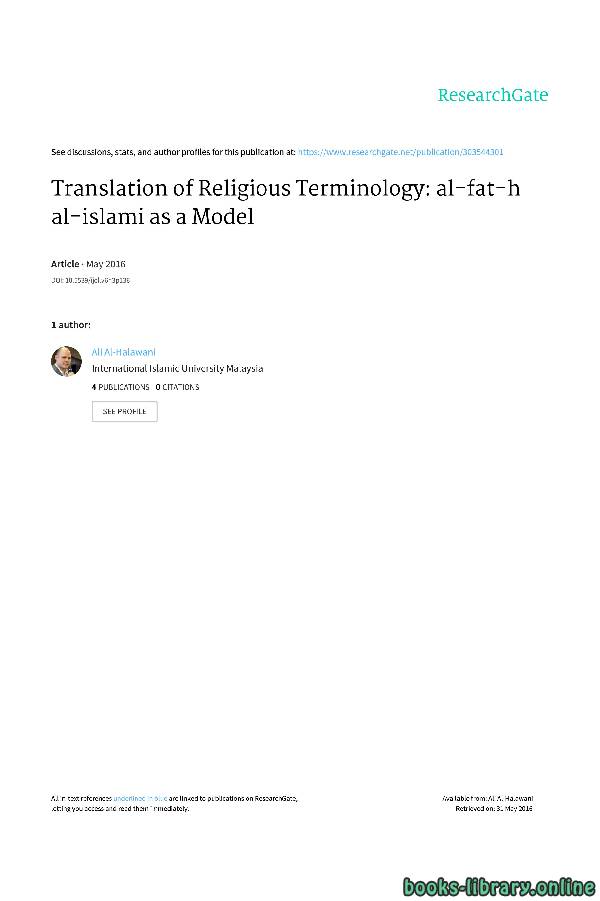📘 قراءة كتاب Translation of Religious Terminology Al-Fat-h Al-Islami as a Model أونلاين


هذا القسم يشمل العديد من الكتب الإسلامية المترجمة بجميع اللغات العالمية منها :
***Islamic Books***: الأقسام الفرعية
English - إنجليزي
Français - فرنسي
Español - أسباني
Indonesian - إندونيسي
Türkçe - تركي
فارسی - فارسي
اردو - أردو
Deutsch - ألماني
Italiano - إيطالي
বাংলা - بنغالي
Русский - روسي
हिन्दी - هندي
മലയാളം - مليالم
ไทย - تايلندي
Filipino - فلبيني
Shqip - ألباني
አማርኛ - أمهري
Bosanski - بوسني
Polski - بولندي
中文 - صيني
Português - برتغالي
한국어 - كوري
日本語 - ياباني
Translation of Religious Terminology: al-fat-h al-islami as a Model
Ali Al-Halawani1
1
Kulliyyah of Languages and Management (KLM), International Islamic University Malaysia (IIUM), Kuala
Lumpur, Malaysia
Correspondence: Ali Al-Halawani, Kulliyyah of Languages and Management (KLM), IIUM, Kuala Lumpur,
Malaysia. E-mail: alihalawani@iium.edu.my or alihalawani72@hotmail.com
Received: March 6, 2016 Accepted: March 27, 2016 Online Published: May 25, 2016
doi:10.5539/ijel.v6n3p136 URL: http://dx.doi.org/10.5539/ijel.v6n3p136
Abstract
This paper is an attempt to illustrate the importance of understanding the religious and cultural background of the
ST in the translation process in order to reach an accurate and precise translation product in the TL. The paper
affirms that differences between cultures may cause complications which are even more serious for the translator
than those arising from differences in language structures. The sample of the study is concerned with an Islamic
term, namely al-fat-h al-Islami-commonly rendered into English as Islamic Conquest or Invasion- a religiously
and culturally bound term/concept. The paper starts by defining culture, and then follows with an extensive
lexical analysis of the selected term/concept. The study proves that it is difficult to translate this concept into the
TL simply due to the lack of optimal or even near optimal cultural equivalents. The skill and the intervention of
the translator are most crucial in this respect because, above all, translation is an act of communication. It is
hoped that this study will provide a more precise equivalent of this significant concept; a matter which may
better reflect the innate peaceful nature of Islam as a religion. The in-depth descriptive analytical method this
study follows can be used to analyze other religiously and culturally bound terms/concepts.
Keywords: translation, religious, cultural, terminology, Arabic/English
1. Introduction
1.1 Background of the Study
Language is a system of communication used by man to express himself and satisfy his/her needs. It is not a
mere representation of facts; rather, it is an embodiment of culture and concepts which are constantly being
formed and shaped, as well as a means of communication and mutual understanding. Culture, as defined by
Newmark (1988, p. 94), is “the way of life and its manifestations that are peculiar to a community that uses a
particular language as its means of expression.” To quote Casagrande (1954, p. 338), “One does not translate
language, one translates culture.” In the same vein, Muhaidat and Neimneh (2011, p. 22) highlighted the fact that
aspects of the ST are not “limited to words on paper” as their far-reaching associations can be historical, cultural,
social or moral. Bassnett (1980, pp. 13-14) considered language as “the heart within the body of culture.” To
Goodenough (1964, pp. 39-40), culture is not “a material phenomenon” as it does not consist of “things, people,
behavior, or emotions.” Rather, it is an organization of all these points together. To add further complexity to the
issue of translating culture, Wolf (2008, p. 12) quoted and translated Said (1997, p. 44) who stated, “All cultures
are hybrid, none is [...] [pure] [...], none is constituted by a homogeneous tissue.” Clearly, this adds more
problems to the existing difficulty of translating cultural terms/concepts as translators have to deal with
diversified aspects of culture even within the same society. Given this, one may say it is of great importance to
attend not only to the lexical or semantic aspect of the ST, but also to its cultural impact and the manner in which
it is perceived in the TL.
When a rendition of a foreign ST is read, access to an unfamiliar culture and a different conceptual system
belonging to a society that speaks another language is thus gained. Such cultural and/or conceptual differences
imbedded in linguistic codes of different societies may often constitute a formidable barrier to the
comprehension of texts. This is a persistent problem that comes to the fore when religious and/or cultural
discourse is involved.
This investigation is particularly concerned with types of terms/concepts whose denotations and connotations go
beyond the limits of their religious and/or cultural nature and extend to the political and media arena; a matter
سنة النشر : 2016م / 1437هـ .
حجم الكتاب عند التحميل : 0.4MB .
نوع الكتاب : pdf.
عداد القراءة:
اذا اعجبك الكتاب فضلاً اضغط على أعجبني و يمكنك تحميله من هنا:

شكرًا لمساهمتكم
شكراً لمساهمتكم معنا في الإرتقاء بمستوى المكتبة ، يمكنكم االتبليغ عن اخطاء او سوء اختيار للكتب وتصنيفها ومحتواها ، أو كتاب يُمنع نشره ، او محمي بحقوق طبع ونشر ، فضلاً قم بالتبليغ عن الكتاب المُخالف:
 قبل تحميل الكتاب ..
قبل تحميل الكتاب ..
يجب ان يتوفر لديكم برنامج تشغيل وقراءة ملفات pdf
يمكن تحميلة من هنا 'http://get.adobe.com/reader/'
Kulliyyah of Languages and Management (KLM)
 ❰ ناشرين لمجموعة من المؤلفات أبرزها ❞ Translation of Religious Terminology Al-Fat-h Al-Islami as a Model ❝ ومن أبرز المؤلفين : ❞ Kulliyyah of Languages and Management (KLM) ❝ ❱. المزيد.. كتب Kulliyyah of Languages and Management (KLM)
❰ ناشرين لمجموعة من المؤلفات أبرزها ❞ Translation of Religious Terminology Al-Fat-h Al-Islami as a Model ❝ ومن أبرز المؤلفين : ❞ Kulliyyah of Languages and Management (KLM) ❝ ❱. المزيد.. كتب Kulliyyah of Languages and Management (KLM) 

 منصّة المكتبة
منصّة المكتبة 